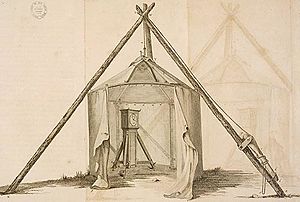William Wales (astronomer) facts for kids
William Wales (born around 1734 – died 29 December 1798) was a British mathematician and astronomer. He is famous for sailing with Captain Cook on his second big journey around the world. Later, he became the head of the Royal Mathematical School at Christ's Hospital and was chosen as a member of the Royal Society.
Contents
Early Life and Learning
William Wales was born in a place called Warmfield, near Wakefield in West Yorkshire, around 1734. When he was young, he moved south with a friend.
In the mid-1760s, William started writing for a magazine called The Ladies' Diary. In 1765, he married Mary Green. Her brother, Charles Green, was also an astronomer.
That same year, William Wales started working for the Astronomer Royal, Nevil Maskelyne. His job was to be a "computer". This meant he calculated special tables called ephemerides. These tables helped sailors figure out their ship's exact location at sea. He did this for Maskelyne's Nautical Almanac, which was a very important book for navigation.
Journey to Observe Venus
In 1769, the Royal Society planned to watch a special event: the transit of Venus. This is when the planet Venus passes directly in front of the Sun. Observing this helped scientists figure out the exact distance between the Earth and the Sun, known as the astronomical unit.
William Wales and his helper, Joseph Dymond, were sent to Prince of Wales Fort in Hudson Bay, Canada, to watch this event. They were promised £200 if their trip was successful. Other teams, like Captain Cook's first voyage, observed the transit from places like Tahiti.
Getting to Hudson Bay was tough! Because of thick ice, they had to start their journey in the summer of 1768, sailing on June 23. William had actually hoped to go somewhere warmer! They arrived at the fort in August 1768.
They had to bring everything with them, not just their telescopes. They even brought materials to build their living quarters. Once there, they built two "Portable Observatories." These were special buildings designed by an engineer named John Smeaton. Building them took a month, and then they had to get ready for the long, cold winter.
Finally, the day of the transit arrived on June 3, 1769. They were lucky to have a clear day and could see Venus crossing the Sun around midday. However, William and Joseph recorded the exact start time of Venus crossing the Sun with an 11-second difference. This small difference bothered William a lot.
They stayed in Canada for three more months before sailing back to England. This made them the first scientists to spend a whole winter in Hudson Bay. When William returned, he was still upset about the different observations. He didn't present his findings to the Royal Society until March 1770. But his report, which included his astronomy results and notes on the weather and plants, was well-received. Because of his good work, James Cook invited him to join his next big journey.
Sailing with Captain Cook
The Board of Longitude chose William Wales and William Bayly to join James Cook on his second voyage around the world from 1772 to 1775. William Wales sailed with Cook on the ship called the Resolution. William's brother-in-law, Charles Green, had been the astronomer on Cook's first voyage but had sadly died on the way home.
On this second trip, William and William Bayly's main job was to test a special clock called the K1 chronometer. This clock was based on a famous design by John Harrison. William Wales kept a detailed logbook of the journey. He wrote down locations, weather conditions, how the instruments worked, and made many notes about the people and places they saw.
Later Life and Recognition
After his return, William Wales was asked in 1778 to write the official astronomy report for Cook's first voyage.
William became the Master of the Royal Mathematical School at Christ's Hospital. He was elected a member of the Royal Society in 1776. Some of his famous students at Christ's Hospital included the writers Samuel Taylor Coleridge and Charles Lamb. People think that William's stories about his travels might have inspired Coleridge when he wrote his famous poem, The Rime of the Ancient Mariner. Another student, Leigh Hunt, remembered William as "a good man, of plain simple manners, with a heavy large person and a benign countenance" (meaning a kind face).
In 1795, he was appointed Secretary of the Board of Longitude, a position he held until he passed away in 1798.
William Wales's work was remembered by others. During his own journey from 1791 to 1795, George Vancouver named a cape in British Columbia "Wales Point" to honor his old teacher. Vancouver had studied astronomy with Wales when he was a young sailor on HMS Resolution during Cook's second voyage. Later, a nearby island was named Wales Island. Vancouver wrote in his journal how grateful he was to Wales for teaching him the skills to explore and map new places.
In 1974, William Wales was featured on a postage stamp from New Hebrides (now Vanuatu). This stamp celebrated the 200th anniversary of Cook finding those islands.
An asteroid discovered in 1998 was named 15045 Walesdymond after both William Wales and Joseph Dymond, his partner on the Hudson Bay expedition.
Works by William Wales
- The Method of Finding the Longitude by timekeepers London: 1794.
See also
- European and American voyages of scientific exploration
- Wales, Wendy (2015). Captain Cook’s Computer: the life of William Wales, F.R.S. (1734-1798). Hame House. ISBN: 978-09933758-0-4.


